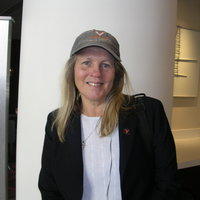The following is a post from Douglas Gregg,
an expert on African Swine Fever Virus
https://www.mail-archive.com/histonet@lists.utsouthwestern.edu/msg36275.html
Hello,
> I have not been on this forum for some time, but still follow it. I am a
> retired veterinary pathologist. Last year I posted an idea for a freshman
> in high school who wants to do a serious science fair project. He is
> already beyond high school science level. His father found me because I
> have been a science fair judge for many years at a nearby school district.
> At first, I declined, citing that I was retired and did not have a good
> project for him. Later I thought about a recent study I read about honey
> bees being infected with an Iridovirus. That caught my attention because I
> did my dissertation and worked for about 10 years on African swine fever
> (ASF) caused by an Iridovirus (now renamed but only moved to a branch
> classification by itself). It is the only mammalian Iridovirus disease.
> Through mass spectrograph studies, and subtraction analysis of normal bee
> data from collapsed colony bees, the US Army found the fingerprint of a
> likely Iridovirus infection in colony collapse syndrome. No one has yet
> confirmed this by other methods that are more conventional and it has not
> been fully accepted due to the new technology used to find it.
>
> So I suggested to Joe, that he could attempt to identify the virus in bee
> larva tissues using histology to find inclusions and immunostaining using
> Vector staining system. I used immunostaining through most of my career and
> was one of the first to identify a virus infection (ASF) with Vector
> staining systems back in the early 80s.
>
> I have a microtome and a few paraffin mold trays and a few plastic
> paraffin tissue holders left over from a consulting project 6 years ago.
> What he will need is some paraplast, more plastic molds, a few metal trays,
> Harris hematoxylin, eosin, slides, coverslips, permount and later PBS, Tris
> and a Vector ABC AP kit which I am very hopeful can be donated by Vector
> when we get that far. I know histo labs often have lots of old unused
> supplies around that don't necessarily fit into current routines or
> machines. If any of you have such supplies that could be used for very
> manual processing of tissues, they would be greatly appreciated. A warm
> water bath is needed too but we can improvise, if necessary.
>
> Having reviewed the literature on honeybee colony collapse syndrome and
> comparing the pathogenesis with African swine fever, an Iridovirus
> infection of bees is a very good fit. I think there is a very high
> likelihood that this could be a big breakthrough in the honey bee collapse
> problem that thus far has not been answered with the many hypotheses
> suggested. This is a worldwide problem that threatens the world food supply
> and must be understood and controlled soon. As a onetime bee keeper, it is
> close to my heart. I hope some of you can help Joe get into histology. He
> is very eager and this could possibly lead to a scholarship or at least a
> workstudy position during college in a histolab someday. Due to the
> recession, his family can't support this project. He has gotten some small
> monetary support from a local bee keeper as well as help acquiring bee
> larva from colonies. I am giving him space to set up a lab in my basement
> and the necessary solvents, etc and lots of training. This is a very
> ambitious project but I think it can be accomplished. He has 2 or 3 years
> to get it finished, and hopefully published. Any help would be appreciated.
>
> Any ideas for crowdsource funding would also be appreciated.
>
> Douglas Gregg DVM, PhD










